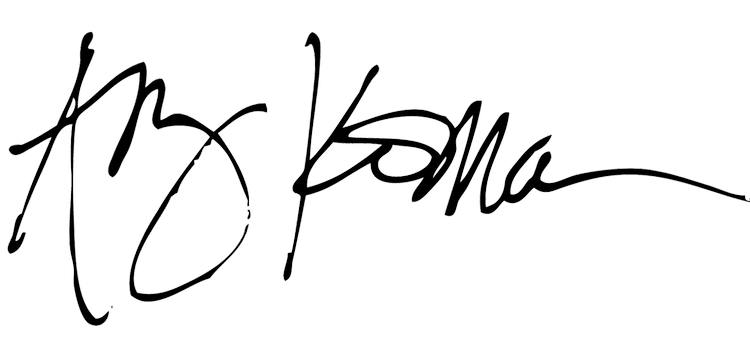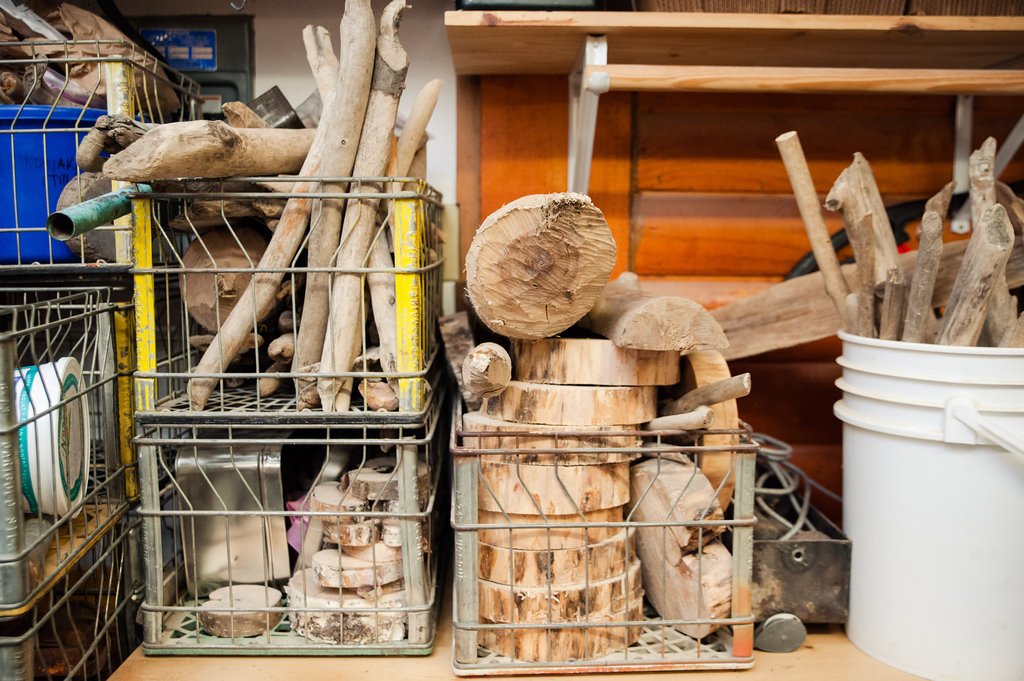By Dorothy Chomicz | Daily News Miner Staff Writer
In a cozy, log-sided house nestled high up in the bowl of Chena Ridge, Amy Komar creates art as she sits at a sun-filled window overlooking a stunning view of Fairbanks and the Tanana River. Though she also paints on canvas and paper, Komar’s most intriguing and popular work features tiny dots of paint rendered in geometric shapes and patterns on rocks and heavy, rusted old keys and tools. The result is deceptively simple yet powerful, and has quickly gained Komar a following in local galleries and shops.
Komar discussed her life and art at her home Friday morning as husband Matt LaPlant, a longtime bartender at Ivory Jack’s, kept their 4-year-old daughter, Lola, and 14-month-old son, Marlo, quietly playing on the floor.
Born in Houston to elementary school teacher Kathy and English professor Ray, Komar knew from a young age she wanted to be creative and expressive in some way, but “didn’t have that epiphany until I ditched my sociology major and started my art classes in college.” After earning an art degree from the University of Texas at Austin in 2001, Komar and a friend decided to drive to Fairbanks from Houston and wait tables at Pike’s Landing for the season. That’s when she caught the Alaska bug.
“I just decided to stay. I wanted to see what it was like to live in a dry cabin, live in the woods and full-on experience the winter,” Komar said.
Komar continued to live the Alaska lifestyle for about three years until she injured her knee while skiing. Realizing she couldn’t haul water or do any of the other things necessary for dry-cabin living, Komar went to live with her parents in Germany, where they had moved when her father got a professorship there. After about six months, she returned to Fairbanks, picked up her truck and her husky, Talia, and drove out of Alaska “with the intent to pick the next place I was going to live based on intuition.”
“I thought, ‘I’m single and totally unattached. When am I ever going to have another chance to have this grand adventure?’” Komar said.
Komar slowly made her way south. She finally stopped in Tucson, Arizona, with $200 in her pocket. Deciding she loved the “beauty and starkness” of the desert, Komar got a job as a fill-in receptionist at Paychex, a national human resources company. She soon worked her way up to a sales representative position but quickly discovered she wasn’t happy in the corporate world.
“It was awesome in that I had a lot of freedom, and I made a decent income and had health insurance, benefits, stock options, but for me it was soul-deadening,” Komar said. “It was the 8-5, weekend warrior thing, and I always had that nudge to make art and I just kept tamping it down, because I had drunk the Kool-Aid of ‘Oh, you’re going to be starving if you’re an artist, it will never work.’”
After two years with the company, Komar quit. She worked part time waitressing as she dedicated herself to painting.
“In 2006, I was turning 30. I just realized that my 20s were gone, and what did I want to do with my life in my 30s?” Komar said.
Feeling the urge to return to Alaska, Komar decided to get people to pay for a painting in advance so she she could finance a trip back to Fairbanks and paint all summer.
“At the end of these months, when I headed back to Tucson in the fall, I would have these people’s paintings finished,” Komar said. “So, I sent out an invitation to about 30 people, humbly asking them to support an emerging artist, and I would use them as my energetic muse. And it worked. It was cool.”
Returning to Tucson that fall, Komar packed up her truck and headed back to Fairbanks for good.
“I just decided that the place I needed to be was in Alaska. I really loved it. I always knew Arizona wasn’t going to be permanent, just temporary. Fairbanks had always felt really good to me,” Komar said. Not long after returning to Fairbanks, Komar reconnected with LaPlant, an old friend she’d worked with at Pike’s Landing. The couple were married about eight months later and Komar dedicated herself to painting. As her work evolved, she started incorporating details such as tiny dots into her paintings.
Amy and Matt | 2010
“As the light would move across the walls I would want the painting to pop and shimmer. I was just starting to make these little dotted lines and people always wanted to touch them and were always remarking about them,” Komar said. I was kind of getting obsessed with making those patterns of dots, and it was Matt who said, ‘Why don’t you try painting on stones?’”
The stone paintings took off. Komar developed an online presence with Etsy, Facebook and her own website. She branched out into painting old tools and keys, which she and Matt find at garage and estate sales. Discovering she liked to work with European keys because they’re more “meaty and well-made,” she had her parents “scour all of the flea markets in Paris and Germany” for the heavy, intricate iron pieces. LaPlant makes all of her frames using weathered wood; the couple’s tidy garage is packed with wood-working equipment, paint brushes and orderly bins of found metal objects. Komar recently started using the same painting technique on pieces of beaver-chewed wood. She is starting to sell of her current stock and ramp up production of new pieces after a slow-down necessitated by the birth of her children.
Fellow Fairbanks artist Madara Mason recently said she considers Komar one of her favorite local artists.
“I think what I like so much about her work is that she manages to elevate commonplace items to something contemplative, joyful and worth looking at. Her objects are usually utilitarian, but her repetitive mark making and mandala-like arrangements remind me that there is beauty in the every-day,” Mason said Sunday.




